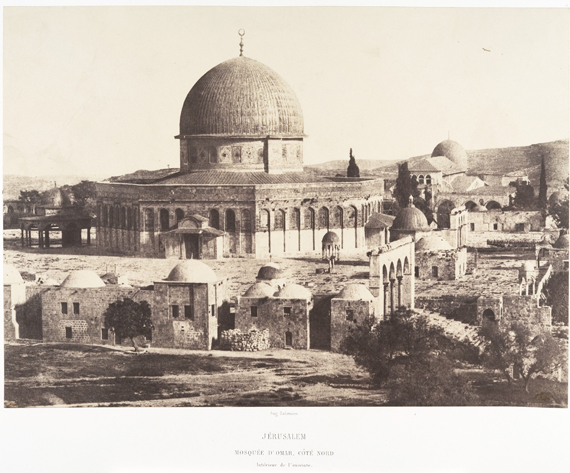
From today's vantage point, the Holy Land seems a region ever immersed in heart-wrenching strife, destined to host unending, unrelenting conflict. But, there are less-known incidents in the long history of Jerusalem, the city at its heart, that allow us to imagine other possibilities.
The year was 1229 according to the Christian calendar, 626 in the Muslim. The previous 130 years had been marked by armed conflict between Christians and Muslims, in which people of both faiths were compelled by an unwavering conviction that Jerusalem was theirs. The medieval Muslim chronicler Ibn Wasil tells us of a flurry of messengers who shuttled between Frederick II Hohenstaufen, Holy Roman Emperor, and Sultan al-Malik al-Kamil in negotiations over the status of Jerusalem. Frederick had come to the Holy Land to lead a Crusade for the recovery of Jerusalem, the sixth such campaign that Christians had launched from Western Europe. Awaiting him was Sultan al-Malik al-Kamil, the nephew and heir of Saladin, the Muslim sultan and general who had routed the Crusaders and reclaimed Jerusalem in 1187.
Neither leader was entirely pure in motive. Al-Kamil had engaged in negotiations with Frederick in an effort to outmaneuver his rival brother; Frederick, by his own account, was seeking an expedient way to safeguard his reputation among his fellow Europeans. Nor did they have public support. Yet they managed, within a matter of months, and without bloodshed, to forge a temporary truce. The Treaty of Jaffa of 1229 was, admittedly, an imperfect agreement, but it made the Holy City open and accessible to the subjects of both rulers for a decade.
In an era marked by Holy War, a peace agreement between sectarian rivals was an extraordinary accomplishment. But perhaps the most remarkable chapter in this story came after the signing of the treaty, outside strictly political channels, in encounters mediated by aesthetic experience. In the city of Jerusalem itself, the beauty of sacred objects and the lyrical sound of prayer provided powerful points of connection between Frederick II and the Sultan's representatives.
Frederick had asked al-Kamil if he might visit the Holy City, a request that was granted. In an attempt to be respectful of Frederick's religious beliefs--and clearly aware that sound respects no barriers--the Sultan's officials had ordered the silencing of the muezzin's nocturnal call from the Aqsa Mosque during his visit. To their surprise, the Christian emperor chastised them the next day, insisting that the very reason he had spent the night in the city had been to hear the call to prayer, for he longed to waken to the sound of the "cries of praise to God during the night."

A 19 century view of the Dome of the Rock. Image courtesy of the Metropolitan Museum of Art.
On that same visit, Frederick was escorted to the Sacred Precinct by the qadi, the presiding Muslim judge. The Emperor expressed his admiration for the construction of both the Aqsa Mosque and the Dome of the Rock. On seeing the minbar, or pulpit, Frederick climbed its stairs to the very top. His exuberant response to this sacred work of art was no doubt a violation of protocol, but that did not concern Ibn Wasil, our chronicler. Rather, he touchingly makes a point of telling us that when Frederick descended, he took the qadi by the hand and out the two went together.
In the midst of seemingly intractable conflict, we long for a cessation of violence, a tolerable détente. To ask for anything more seems naive. Each of these anecdotes, however, allows us to contemplate interactions between enemies that extend beyond mere tolerance. The first story speaks of cultural sensitivity and appreciation through a mutual affirmation of the custom of the other. The second reminds us of the capacity of works of art to bind people together: a shared aesthetic experience long ago prompted the joining of hands.
These are moments when the mystery inherent in beautiful objects and prayerful sound make possible an exceptional atmosphere of fellow feeling. They create a transcendent realm where conflicting sensibilities touch, a set of circumstances where hope ventures tentatively, daringly, to appear.
It was an unlikely time for agreement, let alone concord. But some 800 years ago, at a holy site in Jerusalem, longstanding adversaries enjoyed a rare instance of mutual understanding and shared appreciation of each other's culture. Perhaps no one was more surprised than they.
We might imagine this is why Ibn Wasil inserted these unlikely tales in accounts that largely focus on local political maneuvering. Frederick II must also have had a sense of this when he reported that the treaty with the Sultan had come about "by virtue of a miracle rather than by strength."
In a period wracked with unthinkable violence, two leaders were open to the possibility of a miracle. May it be so in our day.
Barbara Drake Boehm and Melanie Holcomb are curators at The Metropolitan Museum of Art. They are collaborating on an exhibition about Jerusalem in the middle ages for 2016.